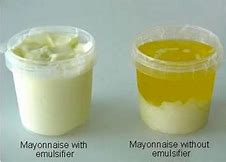ChatGPT said: The role of emulsifiers improve shelf life in packaged goods
Emulsifiers: Key Components for Achieving Completely Combined Solutions
Emulsifiers play a necessary duty in producing secure blends of immiscible fluids, such as oil and water. Their special properties allow them to lower surface area stress, which is crucial for uniformity in different solutions. Recognizing the distinctions between natural and synthetic emulsifiers can affect item quality considerably. As markets progressively seek to improve texture and life span, the choice procedure for the ideal emulsifier becomes extremely important. What elements should be thought about in this essential selection?
Understanding Emulsifiers: What They Are and How They Work
Although emulsifiers may feel like a simple enhancement to solutions, they play a crucial function in stabilizing blends of ingredients that usually do not blend well, such as oil and water. These compounds work by lowering surface stress at the user interface between immiscible liquids, enabling them to mix more uniformly. Emulsifiers contain both hydrophilic (water-attracting) and lipophilic (oil-attracting) residential properties, which enable them to secure themselves at the border of the 2 stages. By doing so, they develop a safety obstacle that protects against the beads of one liquid from integrating right into bigger masses, therefore maintaining a steady emulsion. The effectiveness of an emulsifier depends upon its molecular framework, which affects its ability to stabilize mixtures. In numerous applications, from foodstuff to cosmetics, emulsifiers ensure a consistent texture and look, enhancing both capability and consumer appeal. Their value can not be overstated in achieving well-blended formulations.
Sorts of Emulsifiers: Artificial vs. natural
Emulsifiers can be extensively categorized into two types: artificial and all-natural, each offering unique advantages and applications. All-natural emulsifiers, derived from plant or pet resources, consist of lecithin, periodontal, and casein arabic (emulsifiers). These emulsifiers are typically preferred in clean-label and natural products as a result of their marginal processing and biocompatibility. Their gentle nature makes them ideal for delicate solutions, particularly in food and cosmetics

On the other hand, synthetic emulsifiers such as mono- and diglycerides, and polysorbates are produced via chemical procedures. They are frequently utilized in commercial applications because of their security and efficiency in developing solutions. Synthetic emulsifiers frequently display premium performance in extreme conditions, such as high temperature levels or differing pH levels. The option in between synthetic and natural emulsifiers greatly depends on the certain formulation needs, regulative considerations, and consumer preferences, affecting their efficient application in different industries.
Features of Emulsifiers in Food and Cosmetic Solutions
The function of emulsifiers extends beyond plain stablizing; they are fundamental in attaining the wanted structure, appearance, and rack life of food and cosmetic items. In food solutions, emulsifiers help mix oil and water, creating consistent and smooth structures essential for sauces, dressings, and dairy items. They lower surface area tension, enhancing the security of solutions, which avoids splitting up and prolongs freshness.
In cosmetics, emulsifiers ensure that components, such as oils and water, mix flawlessly, offering a pleasant feeling and boosting application. emulsifiers. They add to the product's thickness and spreadability, essential for creams, lotions, and lotions. In addition, emulsifiers can envelop active ingredients, enhancing their circulation and efficiency in formulations. By controlling texture and enhancing sensory features, emulsifiers play an important duty in conference consumer expectations in both food and cosmetic industries, guaranteeing products are not just appealing check this site out but likewise functionally effective
Choosing the Right Emulsifier for Your Product

In addition, the target look what i found application-- whether for food, cosmetics, or pharmaceuticals-- will certainly influence the selection. Food-grade emulsifiers need to conform with safety and security policies, while aesthetic emulsifiers may call for skin compatibility. Reviewing aspects such as HLB (Hydrophilic-Lipophilic Balance) assists in anticipating emulsifier habits in specific formulas. Inevitably, an extensive assessment of both useful needs and regulatory considerations is necessary to choose the most effective emulsifier, guaranteeing the last item satisfies the preferred quality and security criteria.

Tips for Effective Emulsion Development and Stability
Achieving effective solution development and security requires mindful focus to a number of crucial variables. Initially, the selection of emulsifier plays a pivotal role; it must be suitable with the oil and water stages to assure effective stablizing. Second, the proportion of oil to water need to be well balanced, as an improper proportion can cause instability. Third, the mixing procedure ought to be regulated; high shear blending can assist accomplish smaller sized bead sizes, improving stability.
Temperature level additionally influences emulsion stability; maintaining excellent temperatures during solution avoids premature splitting up. In addition, including stabilizers such as thickeners can additionally boost viscosity, lowering the probability of stage separation. Finally, conducting detailed security tests after formula will certainly aid determine prospective issues, enabling for changes before last production. By adhering to these guidelines, formulators can achieve constant and reliable solutions that keep their desired buildings gradually.
Often Asked Questions
Can Emulsifiers Be Utilized in Vegan Formulations?
Yes, emulsifiers can be used in vegan formulas. Lots of plant-based emulsifiers, such as lecithin from soy or sunflower, offer efficient mixing without animal-derived components, making them Look At This appropriate for a range of vegan items.
What Are Usual Allergens in Emulsifiers?
Common irritants in emulsifiers include soy, dairy products, and eggs, as certain emulsifiers are acquired from these sources. Additionally, some individuals may respond to preservatives or additives made use of alongside emulsifiers in different formulations.

Just How Do Emulsifiers Effect Service Life of Products?
Emulsifiers enhance item security by avoiding separation of components, consequently expanding shelf life. They reduce spoilage triggered by microbial growth and oxidation, leading to long term quality and enhanced quality in various food and cosmetic formulas.
Exist Any Health Worries Connected With Emulsifiers?
Research suggests potential wellness problems related to emulsifiers, consisting of intestine microbiome changes and swelling. While governing bodies generally deem them risk-free, continuous research studies proceed to explore long-lasting effects on health and overall health.
Can Emulsifiers Improve Taste or Aroma in Formulations?
Emulsifiers can enhance taste and fragrance in formulas by enhancing component dispersion and stability. This leads to an extra consistent product, allowing flavors to blend efficiently, inevitably causing a much more satisfying sensory experience for customers.
Emulsifiers may appear like a simple enhancement to formulations, they play a necessary function in stabilizing mixes of ingredients that usually do not mix well, such as oil and water. In food solutions, emulsifiers help blend oil and water, producing smooth and consistent appearances important for sauces, dressings, and milk items. Food-grade emulsifiers need to abide with safety regulations, while cosmetic emulsifiers might call for skin compatibility. Common irritants in emulsifiers consist of soy, milk, and eggs, as particular emulsifiers are derived from these resources. Emulsifiers can improve taste and aroma in formulations by enhancing active ingredient diffusion and security.